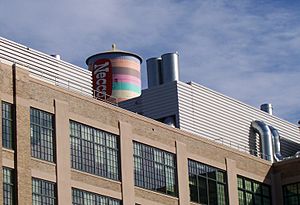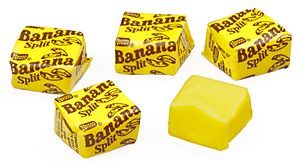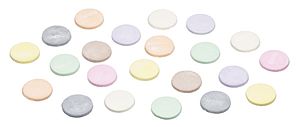Necco facts for kids
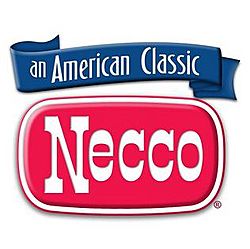 |
|
| Private company | |
| Industry | Confectionery |
| Fate | Operations halted |
| Predecessor | Chase and Company, Ball and Fobes, Bird, Wright and Company |
| Founded | 1847 |
| Defunct | July 2018 |
| Headquarters | |
| Products | Necco Wafers, Sweethearts, Clark Bar and Haviland Thin Mints, among others |
|
Number of employees
|
483 (as of March 2011) |
Necco (also known as NECCO) was a famous American candy company. It was created in 1901 when several smaller candy makers in the Greater Boston area joined together. Some of these companies had been making candy since the 1840s.
Necco was most famous for its candy called Necco Wafers. These wafers were first made way back in 1847. Other popular candies from Necco included the seasonal Sweethearts Conversation Hearts, the Clark Bar, Haviland Thin Mints, and Sky Bar. In July 2018, the company stopped making candy.
Contents
The Sweet History of Necco Candy
How Necco Began
Necco's story started with a company called Chase and Company in 1847. This company was founded by two brothers, Oliver R. and Silas Edwin Chase. They were very clever and invented the first American machine for making candy. The Chase brothers kept creating new machines to make different kinds of candies, like their popular sugar wafers.
Growing Bigger in the 1900s
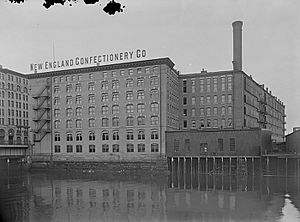
In 1901, two other candy companies joined Chase and Company. These were Ball and Fobes, started in 1848, and Bird, Wright and Company, founded in 1856. Together, they formed the original Necco family.
One year later, these three companies moved into a brand-new factory in Boston, Massachusetts. This new factory became the largest place in the United States dedicated only to making candy. The area around the factory even had streets named Necco Court, Necco Street, and Necco Place.
Because the company was doing so well, Necco started a plan in 1906 to share its profits with employees. This meant workers could get a share of the company's earnings.
Around this time, other candy makers were also becoming famous. David L. Clark started making his own candy bars near Pittsburgh, Pennsylvania. He sold his Clark Bar for five cents and even sent them to soldiers during World War I. Another person, Charles Miller, began making and selling homemade candy in Boston. His Mary Jane candy quickly became very popular.
In 1927, Necco moved to an even bigger factory in Cambridge. This factory was then the largest candy factory in the world.
Necco continued to be a leader in the candy business for many years. During World War II, from 1942 to 1945, the U.S. Government bought a lot of Necco Wafers. This was because the candy didn't melt easily and could survive long journeys.
For a while, Necco was the only company allowed to sell Rolo candy in the U.S. After losing this right to Hershey, Necco made a similar candy called "Milk Chocolate Caramel Roll."
In 1963, Necco was bought by United Industrial Syndicate of New York. Over the years, Necco bought many smaller candy companies. This allowed them to make more popular candies. For example, they bought Stark Candy Company in 1988. This purchase included the famous Sweethearts conversation hearts. By 2000, Necco had 1200 employees.
Necco in the 2000s
In 2003, Necco brought all its operations together into a large factory and warehouse in Revere, Massachusetts. This became their main office. More than 700 people worked there.
The old Necco factory building in Cambridge was later used by Novartis for medical research. In 2005, this historic building was added to the U.S. National Register of Historic Places.
In 2007, a group of investors bought Necco. In 2008, Necco announced it would close its plant in Pewaukee, Wisconsin.
Sale and Closure of Necco
In May 2017, the Necco factory in Revere was sold to real estate companies. Necco was allowed to keep using the factory until August 2018.
In March 2018, Necco's leader announced that most workers might lose their jobs if a buyer for the company wasn't found. Necco was the biggest employer in Revere at the time, with about 500 workers. People who loved Necco candies started buying them online, worried they would disappear forever.
In May 2018, the U.S. Food and Drug Administration (FDA) found serious problems with cleanliness at the Necco factory. There was evidence of rodent activity and unsanitary conditions. This was not the first time such issues were found.
Necco's assets were sold in an auction in May 2018. Spangler Candy Company was the winning bidder at first. However, Spangler later changed their mind. The company was then sold to Round Hill Investments. This company briefly ran the candy factory.
Just two months later, in July 2018, Round Hill Investments announced that the Necco factory in Revere would close immediately. They said they found "sanitation issues" they didn't know about before. About 230 workers lost their jobs when the factory closed. At that time, Necco was the oldest candy company in the United States.
Later, it was confirmed that Spangler Candy Company had bought Necco after all. They planned to start making Necco Wafers, Sweethearts, and Canada Mints again. However, other Necco brands were sold off. The Clark Bar was sold to Boyer Candy Company. Candy buttons went to Doscher's Candies. Banana Split and Mint Julep chews, along with Slap Stix lollipops, went to Mega Candy Co. Haviland Thin Mints and Mighty Malt Milk Balls were sold to Log House Food. Some brands, like Sky Bar, were sold in online auctions. Mary Jane candies were licensed to Atkinson Candy Company.
In October 2019, it was announced that the former Necco factory in Revere would be leased to Amazon to be used as a distribution center.
Necco Candy Brands
- Banana Split chews
- Canada Mints
- Candy Cupboard & Masterpieces
- Candy House Candy Buttons
- Clark Bar candy bars
- Kettle Fresh
- Mary Janes and Mary Jane peanut butter kisses
- Mint Julep chews
- Mighty Malts Malted Milk Balls
- Necco Wafers
- Peach Blossoms
- Sky Bar candy bars
- Slap Stix
- Squirrel Nut Caramels
- Squirrel Nut Zippers
- Stark Candy Raisins
- Sweethearts Conversation Hearts
The Haviland part of Necco also made many candies like Haviland Thin Mints and Bridge Mix.


